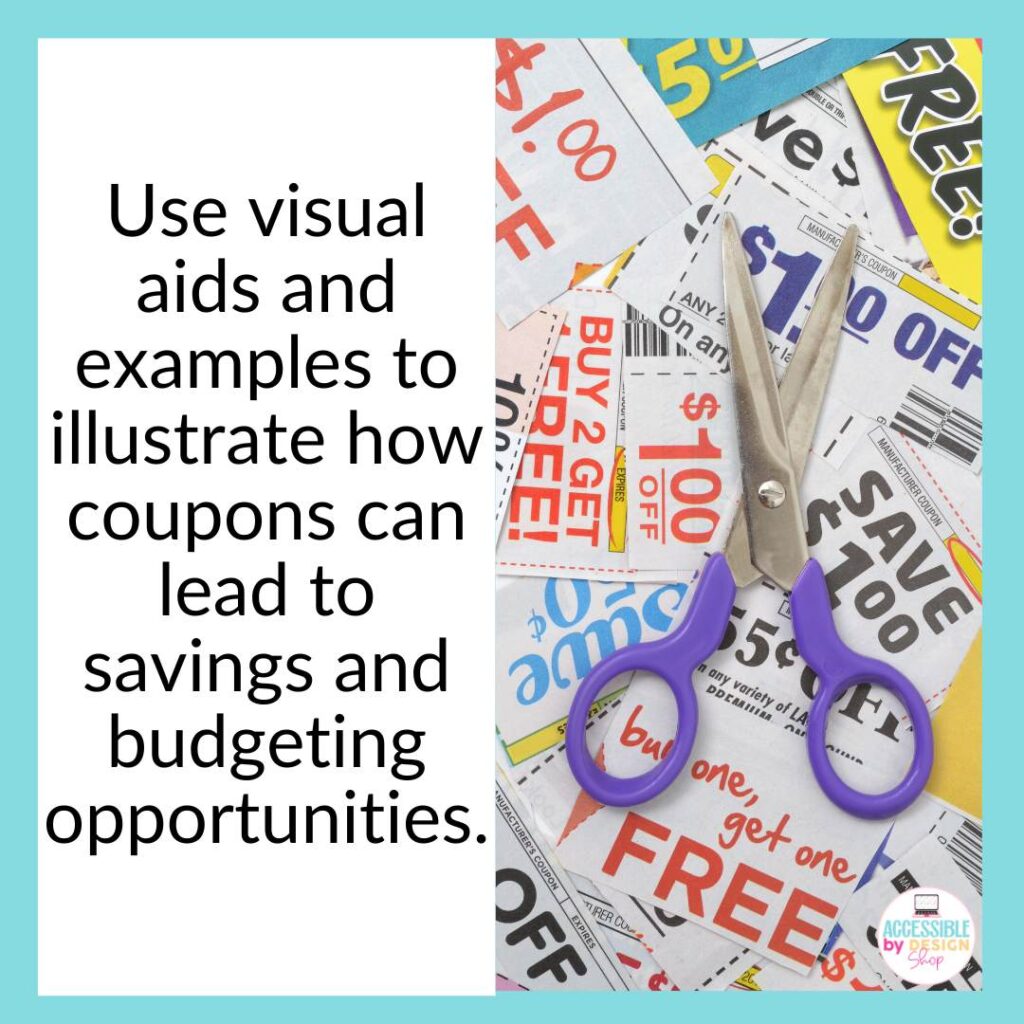6 Tips to Teach about Coupons and Encourage Independent Living Skills
Have you seen those extreme couponing shows where, through the use of coupons, the store owes the customer money after the purchase of a mountain of items? This is fascinating to me as a casual coupon user. And this is another aspect of financial literacy for teens that you can use in your special education classes to encourage independent living skills.
Check out this 10-minute episode where a teen buys nearly $700 in groceries and the store ends up paying him $6! While there’s no need to go to such extremes, it indicates benefits of a financial literary lesson about coupons.
Teaching couponing skills involves math and budgeting skills that will translate to more than that! It involves saving money and promoting independence, which are skills that all students, including students with disabilities, will find useful.
Keep reading for some practical strategies for teaching students with disabilities how to use coupons effectively.
This post is part of a series about financial literacy for teens. Check out this post that introduces teaching tips and strategies for financial literacy lesson plans for the secondary special education classroom.
Financial Literacy for Teens: Using Coupons
The backbone of all of these tips is to provide individualized accommodations and modifications, such as simplified instructions, visual aids, or hands-on activities, to support students with disabilities.
Introduce Basic Concepts of Coupons
Here are two main concepts that should be part of a lesson on financial literacy for teens about coupons.
First, is a brief explanation of what coupons are and what they do. At their most basic, coupons are a way to save money. A coupon offers a discount on products in the form of money off the displayed price and sometimes there are deals to combine for discounts or free products.
Second, is that there are different types of coupons. These include manufacturer coupons, store coupons, and digital coupons. Each one can have a variety of restrictions, including expiring dates.
Use visual aids and examples to illustrate how coupons can lead to savings and budgeting opportunities.
Simplify Couponing Techniques
Using coupons can seem complicated when it’s new but breaking the tasks down can make it more simple and manageable.
Once students have an idea of the ‘big picture’ of how coupons work, zoom in so students can read and understand coupon terms and conditions, such as expiration dates, product requirements, and usage limitations.

In class, collaborate to write out a shopping list. Then scour flyers and online sources for coupons that can work with the list. Demonstrate how to match coupons with items on shopping lists and identify savings opportunities. It’s always better to save money on what you need rather than to save money on something you don’t and therefore just end up spending more money! That alone is a great financial literacy lesson!
Build Math and Budgeting Skills
Coupons are a practical way to reinforce math and budgeting concepts. Teach students how to calculate discounts, determine final prices, and compare prices between products.
This resource bundle all about using coupons is an ideal option for repeated practice since it uses Boom™ cards, that are self-grading. Plus, there are a variety of themes included so they can be used throughout the school year.
Role-Play and Real-Life Scenarios
Incorporating experiential learning supports understanding and knowledge retention too. Here are a couple of ways to include simulated shopping experiences using independent living skills into special education:
- Create mock stores or use online platforms to allow students to plan shopping trips and apply couponing strategies.
- Incorporate problem-solving scenarios that require students to strategize and make informed decisions using coupons.
Utilize Technology and Digital Coupons
Another option to include real-life scenarios is to introduce students to digital coupon platforms such as Flipp and apps such as Rakuten that offer discounts and savings. Teach students how to access and use digital coupons, including scanning barcodes or entering coupon codes. And explore accessible technology options, such as screen readers or magnification tools, to assist students with disabilities in navigating digital coupon platforms.
Collaborate with Parents and Caregivers
When it comes to financial literacy, it’s always great to incorporate parents and caregivers in order to reinforce financial literacy skills at home. Encourage open communication between teachers, parents, and caregivers to ensure consistent support and reinforcement
Encourage parents and caregivers to reinforce couponing skills at home by providing resources, such as websites or mobile apps for finding coupons, to support ongoing practice outside the classroom.

FINAL TAKEAWAY
Teaching secondary special education students how to use coupons will support financial well-being as well asn encourage independent living skills. Reinforcement and application of a variety of different financial skills will promote long-term understanding and success. And couponing will do all of these things plus save money – a win-win scenario!







